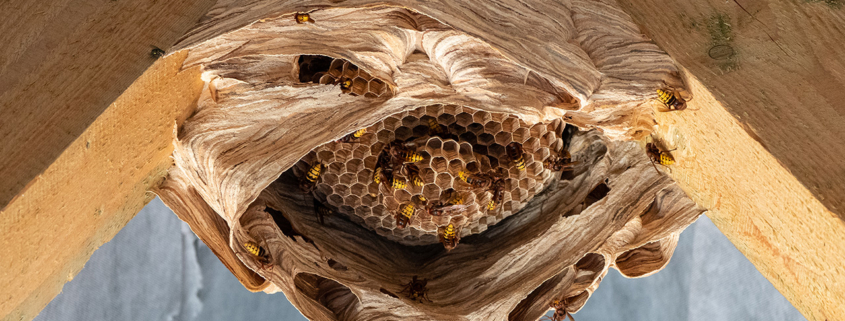Bees, Wasps, Hornets, and Yellowjackets – What’s the Difference?
Bees, wasps, hornets, and yellowjackets are no stranger to the Pacific Northwest. While these insects offer many benefits to the ecosystems in our environment, you don’t want them living with you in your house. The first step of removal and exclusion is identification – and, when it comes to these flying, “stinging” insects, it can be difficult to tell them apart.
You may be wondering which type of pest is most likely to be a nuisance to you and your home. Read below as the expert team at Pest Pros explains the difference between bees vs. wasps vs. hornets vs. yellowjackets.
Types of Bees
There are over 20,000 species of bees in the world. So – what types of bees may be of interest to a Washington homeowner? The bumblebee and the carpenter bee are two common types of bees that may live around your home. Both types of bees can be easily identified by their furry body which regulates their body temperature and can act as an automatic pollen collector.

Bumblebees are almost harmless to homeowners since they nest in wax combs that hold their honey. Similarly, honey bees nest in wax combs however they produce honey in a much higher quantity and sometimes nest in the walls of houses which can be a danger to a house’s infrastructure.
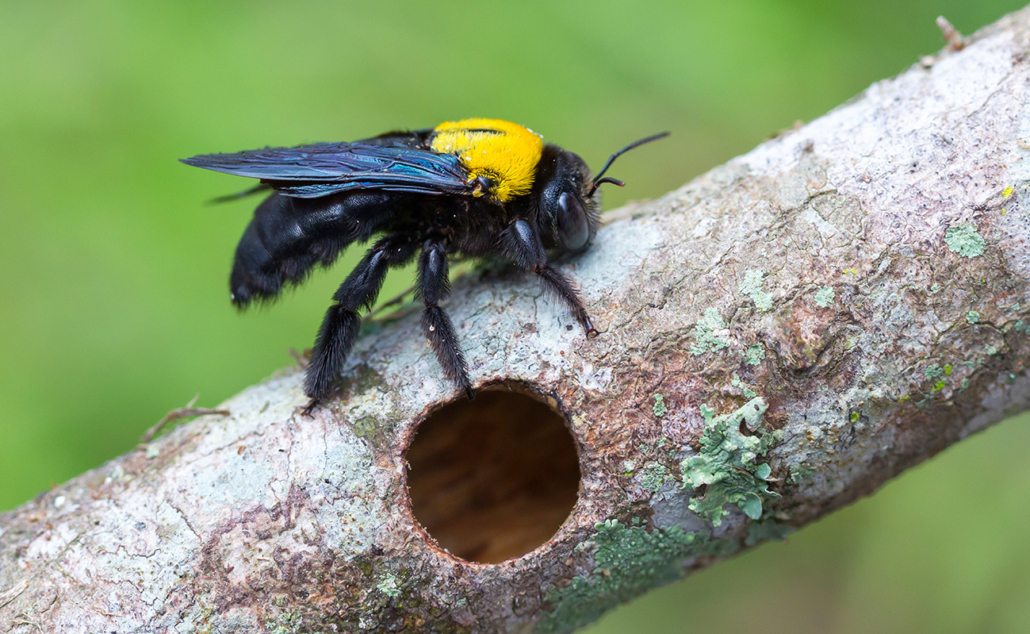
Carpenter bees, also known as wood bees, raise a mild threat to your house because they nest by drilling into wooden structures such as the baseboards of a house. Although their impact could lead to structural damage, it is uncommon that a carpenter bee raises serious trouble for a homeowner.
Bees, Wasps, and Hornets
The primary difference between bees, wasps, and hornets is the duties they carry out within the natural ecosystem, which also differentiates their diets. Bees are herbivores — meaning, they primarily eat plants and pollinate. Comparatively, wasps and hornets are omnivores, which means they prey on other insects as well as eat plants. As predators, wasps and hornets can help homeowners get rid of other unwanted insects in their homes but bring their own risks to the table.
Types of Hornets
Hornets are not naturally aggressive, but they are aggressive to humans and other nuisances that invade their space and threaten their colony. Bald-headed hornets are a common type of hornet in the Pacific Northwest.
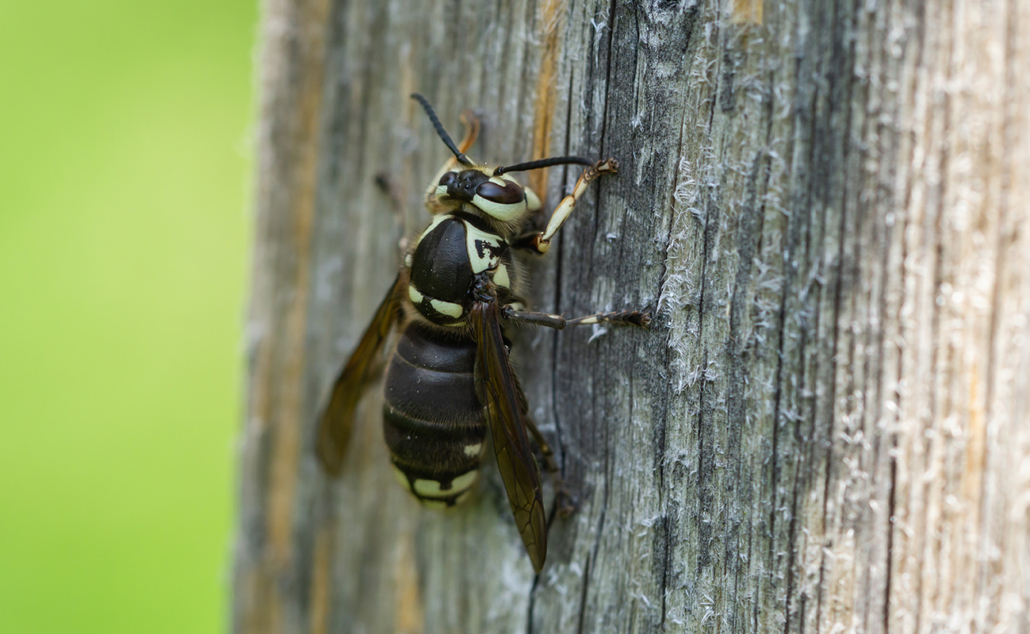
The jack of all trades, the bald-faced hornet, may nest in multiple locations; tree branches, a bush, the side of your home, garages, and other outdoor areas of your house.
Despite being just as aggressive as yellowjackets, bald-faced hornets can be distinguished by their white head and all-black body, which differs from yellowjackets’ black and yellow body.
Types of Wasps
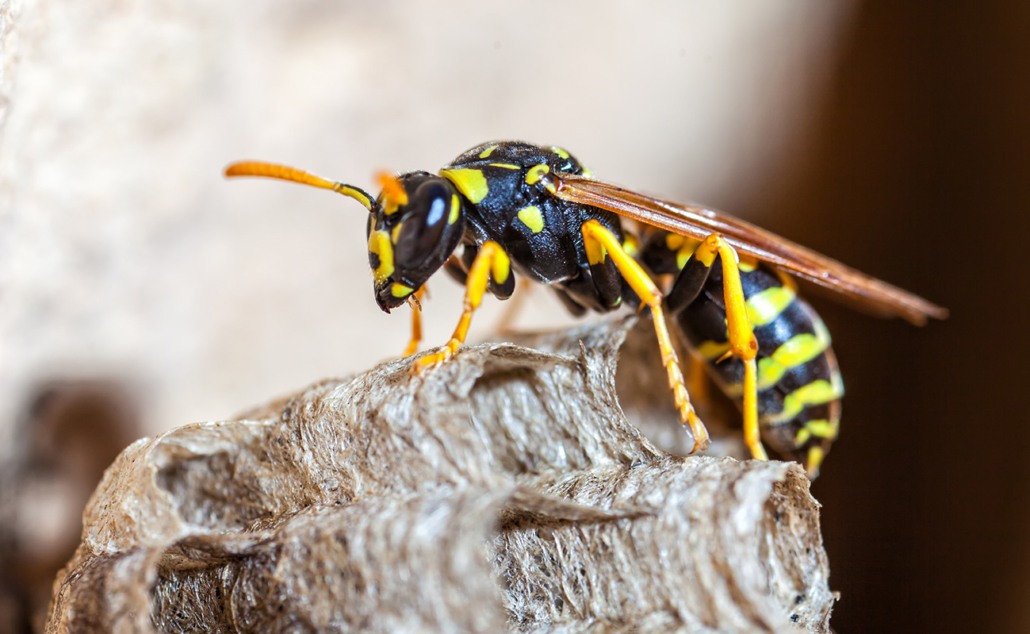
Similar to hornets, wasps will also become aggressive when they feel threatened. Wasps are black and yellow, however, are distinguishable from a bee by their slender and hairless body. Paper wasps are the most common type of wasp in Washington and tend to be solitary wasps.
Social wasps may choose to nest near neighborhoods and houses, especially in park areas. This may be a physical threat where outside activity is common. However, social wasps are less of a threat to homeowners as they typically nest in trees, leaves, branches, and other areas of nature.
Solitary wasps may cause trouble to homeowners as they can nest in sheltered places such as porch ceilings, roof corners, and other partially enclosed areas.
Yellowjackets vs. Wasps
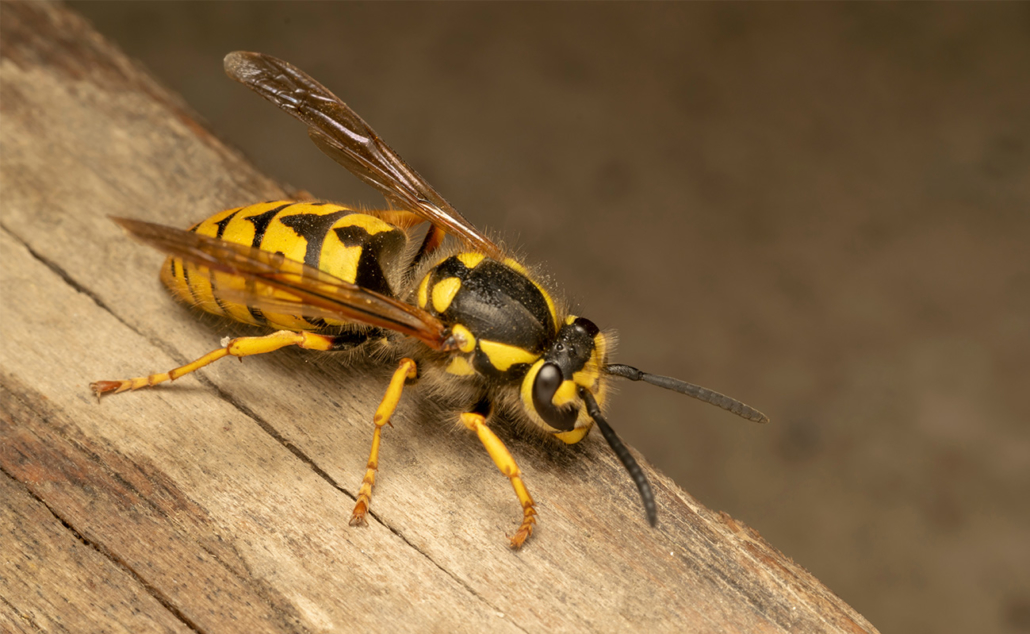
The yellowjacket, a common pest in the Pacific Northwest, is a member of the wasp species. The difference between yellowjackets and other wasps is that yellowjackets tend to be more curious and aggressive than the average wasp. You can easily identify yellowjackets by their black and yellow slender body.
Yellowjackets are attracted to content such as food and garbage. Yellowjackets will swarm areas with these smells to assess whether it’s a good place to find fuel and to nest near. This pest likes to nest closer to the ground in sheltered, dark corners such as house attics and deck stairs.
The good news is that they are known for killing other pests that you may not want in or around your home such as house flies. The bad news is that they are more persistent and aggressive than the average pest they may be preying on.
Why are Bees, Wasps, and Hornets Problematic?
While bees, wasps, and hornets have their differences, they all can be classified as pests that homeowners don’t want to intrude into their homes. Bees, wasps, and hornets all find house structures and backyards the perfect place to create a home for the season, which is a reason to take preventative measures to ensure your house is protected. Pests like carpenter bees, paper wasps, bald-faced hornets, and even honeybees can be a threat to your home’s insulation and infrastructure.
Carpenter bees create circular tunnels throughout the wooden structure of homes causing them to become weak and eventually sink or bust. Similarly, solitary wasps, like paper wasps, will also drill into the wood infrastructure of houses causing damage to the foundation of a home.
Although less common, honeybees will choose to nest within house walls. The honeycomb formed in the nests can directly damage the insulation of your home, especially after the bees abandon the comb, leaving melted honey behind.
Not to mention that an infestation can be a physical danger to you and your family when bees, wasps, hornets, and yellowjackets create a nest on your property.
Signs You Have Bees, Wasps, Hornets, and Yellowjackets in Your Home
Having a bee, wasp, or hornet infestation is often easy to identify due to each of their pesky nature. However, if you are unsure, here are some common signs that you may have a pest problem:
- Increase in bee activity around the house
- Smooth round holes in wood infrastructure on the outside of the house
- Sawdust piles
- Structural damage to the outside of the house
- Sound of buzzing in your walls
- Dark spots on the inside and outside of the house walls
How Do You Get Rid of Bees, Wasps, and Hornets?
Prevention
Homeowners should take preventative measures to stop bees, hornets, and wasps from infesting their homes and property.
- Repair any cracks along with the siding of your house
- Repair and seal cracks around house windows and doors
- Keep all food and garbage stored in tightly closed containers
- Use natural repellents like peppermint oil or dryer sheets around your home, sunroom, and porch areas
DIY Solutions
If you do encounter an increase in bee, wasp, or hornet activity around your home, you can try these DIY solutions for dealing with these pests. However, dealing with these pests can be dangerous, especially when going to the source of the infestation. DIY solutions rarely solve the problem but instead worsen the issue so it’s more difficult for professionals to solve once they’re called. The best solution for pest infestations is finding professional pest spraying services.
If you do tackle a DIY solution, be sure to take the safety protocols needed such as wearing protective face and body gear and planning an escape route to ensure you have a way out if the bees, wasps, or hornets attack.
Natural
- Spray an infested area including the nest with a soap and water mixture.
- Create homemade traps with a sugary substance such as soda or fruit juice.
Unnatural
- Spray an infested area with insecticides – a product created to kill pests and their nest.
Contact a Professional Pest Control Company: Pest Pros
If you find that you have a bee, wasp, or hornet infestation, the best solution that we recommend is to call a professional pest control company, like Pest Pros.

- Inspect and identify the type of bee, hornet, or wasp
- Exclusion – limiting the pest to a confined area
- Least-invasive pest treatment
- Additional pest services (if needed)
- Maintenance
Pest Pros technicians are prepared to provide expert knowledge about the best practices for dealing with each type of bee in the least invasive and safest way possible. Using professional pest control services such as Pest Pros ensures that the job is done right and safely.
It is Pest Pros’ top priority to offer services that will prevent your house from further damage, and future infestations and ensure your house feels like a home. Our team is prompt, professional, and dedicated to taking care of any pest problems in your home and getting your life back to normal. Call us or contact us for your free estimate today!

